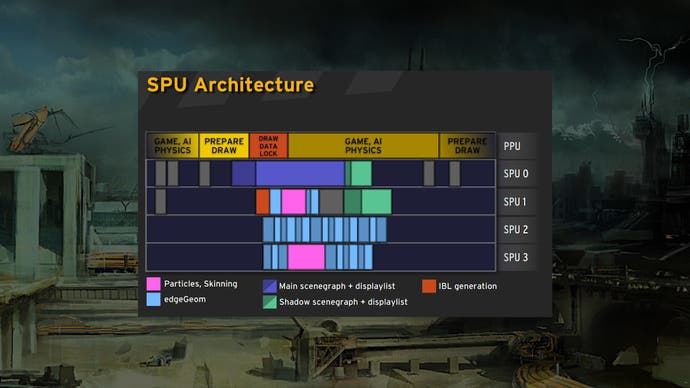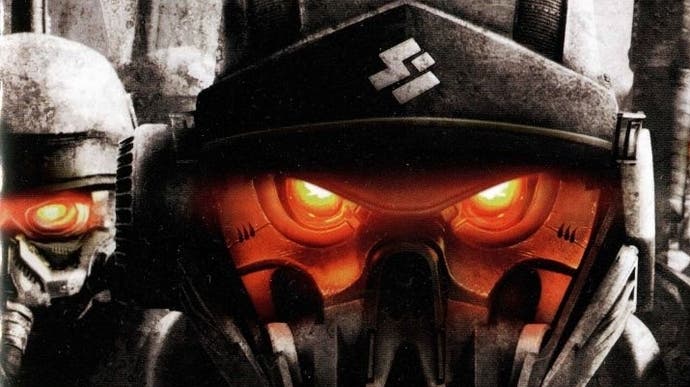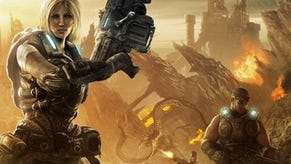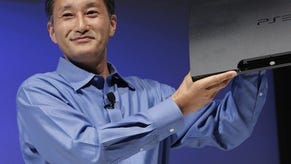DF Retro: Killzone 2 ten years on - a PS3 showcase that still looks stunning today
Guerrilla warfare.
The road to Killzone 2 was almost certainly a difficult one fraught with unrealistic expectations defined by its infamous E3 2005 pre-rendered trailer - but despite the odds, developer Guerrilla Games managed to produce one of the most visually striking games of the generation. Even today, Killzone 2 stands head and shoulders above most games released for PlayStation 3 in terms of both technical ambition and artistic vision. Revisit the game yourself and see what I mean - it still looks stunning.
The original Killzone released on PS2 in 2004 to average reviews, but there was a spark there that suggested the potential for something greater. The atmosphere was thick and the visuals ambitious for the platform, animation on weaponry was remarkably robust and the game even featured multiple playable characters. Unfortunately, Killzone is ultimately let down by a remarkably choppy frame-rate and often poor mission design, but for many, the Killzone name and Guerrilla Games itself only took centrestage at E3 2005 with the reveal of PlayStation 3.
This now infamous trailer showcased a level of detail and fidelity unlike anything we could imagine at the time and for good reason - the trailer was completely pre-rendered and, according to Guerrilla, was never intended to represent the final game. Indeed, some sources tell us it was never meant for public consumption. The Amsterdam-based studio barely had a single triangle displaying on PS3 devkits at the time, but thanks to a comment made by Sony exec, people were led to believe it was real. As a result, this trailer potentially made development of the game more difficult for the team with public expectations centered around a piece of media that simply wasn't representative of what could be achieved. It would be two years before we saw Killzone 2 again, and three-and-a-half years before the final game would emerge.
At E3 2007, Killzone 2 received its first proper reveal with a new look at the game running on actual PlayStation 3 hardware. No, it didn't match that pre-rendered trailer but the team got closer than anyone could have imagined in terms of pulling off the look and feel. In fact, from a pure artistic vision point of view, I'd say the team exceeded expectations. Killzone 2 looked tremendously impressive, while the final product - released in 2009 - proved to be something very, very special indeed, especially from a technology perspective.Killzone 2 was a stunning showpiece for the PlayStation 3, sporting large environments with a visual focus on post-processing, dynamic lighting and alpha effects. It was phenomenal.
These days, describing something as dark or gritty is typically met with a raised eyebrow but it's fundamental to Killzone 2's aesthetic - and it works beautifully. There is an overwhelming sense of dread throughout the game: thick, billowing clouds fill the skies, flashes of lightning briefly illuminate the scene, powerlines violently whip across city streets and particles float effortlessly through the ash filled air. As your boots hit the ground, a carefully designed camera bob simulates movement through the environment while a strategically applied depth of field effect is used to accentuate the weapon model. Every motion of your hands is perfectly realised - every reload perfectly executed. It looks remarkable in action, even today.
One of the key goals when designing Killzone 2 was to deliver realistic and distinctive lighting, enabling a huge number of dynamic lights per scene. To achieve this, the team developed an engine designed to utilise the PlayStation 3 hardware effectively - this means leveraging the Cell processor's satellite SPUs to aid the underpowered RSX whenever possible, while keeping memory requirements reasonable. The SPUs are used for elements such as particles, skinning, triangle culling, image based light generation and more.
When Killzone 2 shipped, deferred rendering in games was still relatively new in shipping games and this game highlighted some of the benefits. By utilising a separate buffer, known as a G-buffer, to store image information pertaining to different passes such as depth, normals, albedo and the like, some new possibilities are opened. The primary advantage centres on decoupling scene geometry and lighting. Lights are slow when using pure forward rendering as each light requires an extra pass and thus more processing time. The deferred approach used here allows the artists to pack each area with lots of dynamic lights without a huge performance cost.
As a result, lights are everywhere. Every single enemy and friendly includes individual point lights affixed to their combat attire while explosions and gunfire produce huge bursts of light all around the battlefield. Lights can be included all over and it greatly contributes to the unique look and feel of the game. Of course, deferred rendering doesn't play nicely with transparencies, so for things like smoke particles and fire, a second forward pass is used after the lighting pass. Some might say that it's a very 'forward'-looking approach.

What I love about the dynamic lights in Killzone 2 is that many of them can cast shadows. No matter where you are in the world, the muzzle flash from your weapon always casts shadows from both dynamic and static objects. The same is true for the flashlight available on the shotgun. Muzzle flash shadows are still relatively uncommon in modern games so to see this in a 2009 release is quite a treat.
The world, however, uses a mixed solution with static scene geometry using pre-computed light-maps. This tried and tested method of world lighting works well here - time of day is never dynamic, so Guerrilla's artists were able to generate very dramatic scenes. The approach to baked lighting also takes care of ambient occlusion on static objects - this is a game that lacks real-time screen-space AO, which was only just starting to appear in console games in 2009, but it doesn't feel flat in the same way as games like Insomniac's Resistance 2.
And everything is viewed through a very dynamic first-person point of view. Every gunshot is punctuated with a burst of light as the barrel snaps back and shell casings fly off to the side. Every weapon has a remarkably detailed reloading animation and the level of detail visible across each weapon remains impressive to this day. Actions such as climbing ladders receive detailed first-person animation while one section has you commanding a mech across the battlefield with a detailed cockpit that sways realistically as you stomp around the battlefield.
Killzone 2 introduces iron sights to the series as well - something that had become popular following games such as Call of Duty 4 and Crysis. I love the animation used for scoping in and out in Killzone 2 and the application of depth of field further enhances this. The weapon model is also designed to situate itself based on proximity to certain surface - when using the cover system, for instance, your character adjusts his rifle based on position. There are other camera effects used to enhance the presentation: lens flares are used in conjunction with bright sources of light while dirt and debris collect on the camera. Killzone 2 does seem to lack full body awareness, which would be added in Killzone 3, but it still conveys the sensation of being anchored to the world. At least your character can cast shadows across the environment.

Speaking of characters, the rest of the cast appears quite detailed for a 2009 first-person shooter, though they don't hold up quite as well as the weapon models. From a 2019 perspective, it's clear that the texture work and shading look a touch dated now, but they still work within the artistic design of the game. The smooth animation of friendly and enemy characters adds tremendously to the presentation. Per-object motion blur is used on everything to enhance fluidity. The shutter speed is low, but it remains mostly artefact free.
Really, though, what makes Killzone 2 look so great in motion goes beyond individual animations and effects - it's the sheer volume of interactive objects in the world and the way they work in conjunction with combat that works so well. There's also the selective destruction where a layer of geometry is applied to certain objects that can be blown apart during combat. It's limited but it adds a lot to the combat experience. Then there are some really nice sparks and other effects that bounce off surfaces realistically, while debris is generated from shooting stone and dirt.
It's the same story with enemy behaviour and animation. Inverse kinematics are present, allowing proper foot placement on sloped surfaces. Helghast foes flee for cover and generally behave in interesting ways. Compared to Call of Duty, where enemies would function as pop-up targets most of the time, the Helghast are active and move around during combat. You can also shoot off enemy helmets and the way they react to heavy gunfire is just excellent. There's a sense of weight to the enemies lacking in many other shooters from this era.
There are plenty of other cool visual effects included throughout that also deserve a mention. The scanline filter applied to various screens throughout the game is gorgeous revealing the individual RGB elements of these displays. Then there are the fake volumetric light shafts - this was made prior to things like screen-space crepuscular rays and true volumetric lighting would have been too demanding at this point, no doubt, though Naughty Dog did come up with a neat solution for Uncharted 3. Some areas of Killzone 2 even use parallax occlusion mapping - a technique that only really became commonplace in the current generation.
Moreover, Killzone 2 runs at a full 720p with 2x MSAA. It's the quincunx variety but, in this case, the slight blur is beneficial and helps produce a smoother, more filmic overall image, bolstered by the application of a layer of film grain. Overall, Killzone 2 is a huge accomplishment in terms of bringing deferred rendering to the forefront, and in its use of cinematic special effect. There's just nothing else quite like it.
Of course, that's not to say that everything is quite perfect. As impressive as the game looks, the frame-rate isn't always on point. Basically, the game targets 30 frames per second and it often reaches it but heavy combat sequences, can see noticeable drops, but at the same time, this is the PlayStation 3 and many other shooters from this generation, save for Call of Duty, struggled to hit 30fps. Last gen was much worse in terms of holding a stable frame-rate than the PS4 and Xbox One are, that's for sure. So, with that in mind, performance isn't really half bad. Killzone 3, though, offers an improvement in this area.
So, for all the visual talk then, how does the game itself hold up ten years on? Revisiting Killzone 2 is an interesting experience. This is a game built during the height of the Call of Duty craze where campaigns were often very linear and focused on very specific sections. Killzone 2 somehow falls right between Call of Duty 4 and Halo. It's not as scripted and you have more agency to move around the battlefield during combat, but it lacks the wide-open feeling of Halo.
It also has one serious problem that continues to plague the game to this day - input lag. There is a ton of input latency in this game and it doesn't feel responsive to play at all, which made getting through it somewhat of a chore at points. Either way, this was never fully addressed until Killzone 3 which features much snappier controls all around.
Indeed, the sequel revamps the Killzone formula significantly. There is a shift in focus from the heavily post-processed, oppressive look of Killzone 2 to something a little brighter. There's more colour in the presentation, the MSAA has been replaced with post-process MLAA which results in a more aliased image with more shimmering, while elements like muzzle-flash shadows are mostly missing. Many of the smaller details in Killzone 2 have been eliminated in pursuit of a larger game world and a more complex mission design. It's a gorgeous game in its own right and the team made a lot of steps in the right direction, but it's lacking that certain spark that makes Killzone 2 feel so unique.
And with that in mind, it's such a shame that Killzone 2 exists solely on PlayStation 3. Across this generation, many of the greatest PlayStation 3 games received ports to PS4 and Pro - a 60fps collection featuring Killzone 2 and 3 would have been an amazing remaster to receive. For now though, Killzone 2 lives only on PS3 and there it will likely remain. It's not a perfect game and its initial reveal was misused by Sony, deceiving fans worldwide. However, with the final release, Guerrilla Games triumphed, delivering one of the most fascinating shooters of the generation.

















